-

Lisbon massacre
The Lisbon massacre (alternatively known as the Lisbon pogrom or the 1506 Easter Slaughter) was an incident in April, 1506, in Lisbon in the Kingdom of Portugal in which a crowd of Catholics, as well as foreign sailors who were anchored in the Tagus, persecuted, tortured, killed, and burnt at the stake hundreds of people who were accused of being Jews and, thus, guilty of deicide and heresy. This incident took place thirty years before the establishment of the Portuguese Inquisition and nine years after the Jews were forced to convert to the Catholic Church in 1497 during the reign of King Manuel I.
-

Slovene Peasant Revolt
The Slovene Peasant Revolt (Slovene: slovenski kmečki upor, German: Windischer Bauernbund) took place in 1515 and was the largest peasant revolt in the Slovene Lands. It engulfed most of what is now Slovenia. There were about 80,000 rebels who demanded the reintroduction of the original feudal obligations and trade rights (the so-called "old rights"; Slovene: stara pravda) and a right to decide about the taxes. The spark which started this uprising was when the ethnic German peasants of the Gottschee region killed their lord Jorg von Thurn. They attacked the castles within the region, except in the territory of the County of Görz, where conflicts were solved through negotiations. The revolt was put down by the mercenaries of the Holy Roman Empire, with the deciding battle fought at Celje. The words stara pravda were printed in 1515 in Vienna in a poem of the German mercenaries and were the first printed Slovene words.
-

Motín del pendón verde
Se conoce como motín del pendón verde al levantamiento popular que tuvo lugar en la ciudad de Sevilla (España) el 8 de mayo de 1521 con motivo del hambre que padecían los habitantes del barrio de Feria. Recibe este nombre porque los amotinados enarbolaron contra las autoridades una enseña verde que había sido tomada a los almohades y que se guardaba en la capilla bautismal de la parroquia de Omnium Sanctorum, situada en dicho barrio.
-

Anabaptist riot
The Anabaptist riot of Amsterdam or Wederdopersoproer generally refers to an event on 10 May 1535 in which 40 Anabaptists occupied the city hall. The city guardsmen stormed the city hall and in the battle that ensued, the mayor Peter Colijn, 20 militiamen and 28 Anabaptists were killed. The surviving Anabaptists were executed in a particularly gruesome manner: their hearts were cut out of their breasts while still alive, their bodies were drawn and quartered, and their heads were stuck on pikes and posted at the city gates. The event was commemorated in a painting by Barend Dircksz.
-

1562 Riots of Toulouse
The 1562 Riots of Toulouse are a series of events (occurring largely in the span of a week) that pitted members of the Reformed Church of France (often called Huguenots) against members of the Roman Catholic Church in violent clashes that ended with the deaths of between 3,000–5,000 citizens of the French city of Toulouse. These events exhibit the tensions that would soon explode into full civil war during the French Wars of Religion.
-
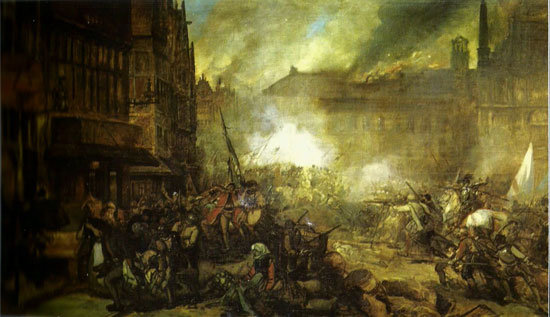
Motín de Haarlem
El motín de Haarlem es el primer motín de los tercios españoles en Flandes, ocurrido en julio de 1573.
-
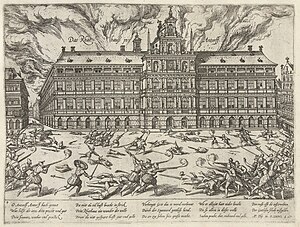
Motín de Aalst
El motín de Aalst es uno de los muchos motines que hubo entre las tropas españolas de los tercios, ocurrido en 1576 durante la Guerra de los Ochenta Años.
-
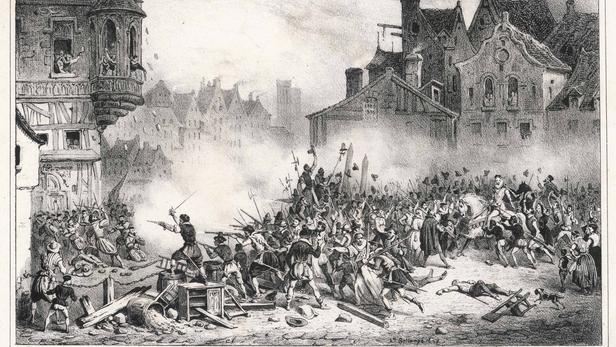
Day of the Barricades
In the French Wars of Religion, the Day of the Barricades (in French: Journée des barricades), 12 May 1588, was an outwardly spontaneous public uprising in staunchly Catholic Paris against the moderate, hesitant, temporizing policies of Henry III. It was in fact called forth by the "Council of Sixteen", representing the sixteen quartiers of Paris, led by Henri, duc de Guise, head of the Catholic League, and coordinated in detail by Philip II of Spain's ambassador, Bernardino de Mendoza.
-

Muiterij van Diest
De Muiterij van Diest is de naam van een drietal muiterijen van Spaansgezinde soldaten die, ten tijde van de Tachtigjarige Oorlog, plaatsvonden tussen 1589 en 1607.
-

Haager Bauernaufstand
Der Haager Bauernaufstand war ein Aufbegehren der Bauern in der bayerisch dominierten Reichsgrafschaft Haag gegen den bayerischen Herzog im Jahr 1596.
-
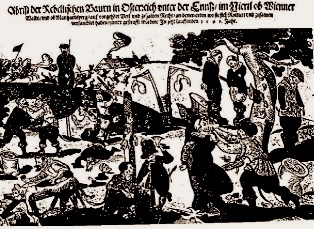
Niederösterreichischer Bauernaufstand 1596/1597
Die Niederösterreichischen Bauernaufstände in den Jahren 1596 und 1597 waren ein Bauernaufstand in Niederösterreich, der sich gegen die Grundherren richtete. Er stand in Zusammenhang mit dem Zweiten Oberösterreichischen Bauernaufstand (1595–1597).
-

Révolte d'Arganda
La révolte d'Arganda est un événement qui a eu lieu dans la ville d'Arganda del Rey en 1613. Elle a été causée par la perte du privilège d'être une ville du domaine royal et le Duc de Lerma, Francisco de Sandoval y Rojas, premier duc de Lerma en est l'acteur malheureux.
-

Fettmilch Aufstand
Der Fettmilch-Aufstand (auch „Fedtmilch- Aufstand“) des Jahres 1614 war eine von dem Lebkuchenbäcker Vinzenz Fettmilch angeführte judenfeindliche Revolte in der Reichsstadt Frankfurt am Main. Der Aufstand der Zünfte richtete sich ursprünglich gegen die Misswirtschaft des von Patriziern dominierten Rats der Stadt, artete aber in die Plünderung der Judengasse und die Vertreibung aller Frankfurter Juden aus. Er wurde schließlich mit Hilfe des Kaisers, der Landgrafschaft Hessen-Kassel und des Kurfürstentums Mainz niedergeschlagen.
-

1619 Jamestown craftsmen strike
The Jamestown craftsmen's strike of 1619 took place in the settlement of Jamestown in the Virginia colony. It was the first documented strike in North America. Skilled craftsmen were sent by the Virginia Company to Jamestown to produce pitch, tar, and turpentine used for shipbuilding. When the colony held its first election in 1619, many settlers were not allowed to vote on the grounds that they were not of English descent, and they went on strike. Due to the importance of the skilled workers in producing valuable naval stores for the colony, company leaders bowed to labor pressure and gave full voting rights to continental workers.
-

Peasants' War in Upper Austria
The Peasants' War in Upper Austria (German: Oberösterreichischer Bauernkrieg) was a rebellion led by farmers in 1626 whose goal was to free Upper Austria from Bavarian rule. The motive (found in the Frankenburger Würfelspiel of 1625) was an escalation of the Bavarian kingdom's attempt to press the country into the Catholic faith at the time of the Thirty Years' War.
-

Maldon grain riots
The Maldon grain riots took place in January 1629, in the midst of industrial depression and poor harvests. The English cloth trade had slumped in January, leading to more pressure on agriculture to satisfy export demand. Starvation and high food prices in Essex only exacerbated the strain on the agrarian economy. Discontent was thus harboured when those starving in Essex watched grain being loaded on to ships to be exported to Europe. In March of that year, a 100- to 140-strong group of rioters led by one "Captain" Ann Carter, the wife of a butcher, boarded a Flemish grain ship. There was a widespread belief at the time that women were beyond the law, since any prosecution could only be made against a male who might lie behind a crime; it was commonplace for a husband to be held legally accountable for the actions of his wife (refer to Legal rights of women in history). The women and child rioters removed some grain from the ship by filling their caps and gowns.
-
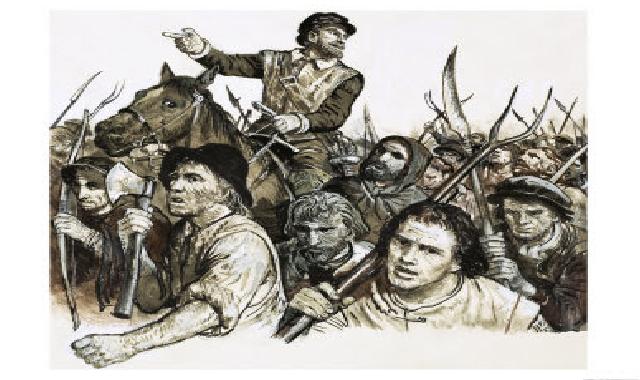
Second Slovene peasant revolt
no info
-

Shimabara Rebellion
The Shimabara Rebellion (島原の乱, Shimabara no ran), also known as the Shimabara-Amakusa Rebellion (島原・天草の乱, Shimabara-Amakusa no ran) or Shimabara- Amakusa Ikki (島原・天草一揆), was an uprising that occurred in the Shimabara Domain of the Tokugawa Shogunate in Japan from 17 December 1637 to 15 April 1638.
-

Revolt of the va nu pieds
The Revolt of the va-nu-pieds (French pronunciation: [vanypje], barefooted ones) was a popular uprising in Normandy in 1639 following Louis XIII of France's decision to set up the gabelle in Cotentin in place of the privilege of the quart-bouillon.
-
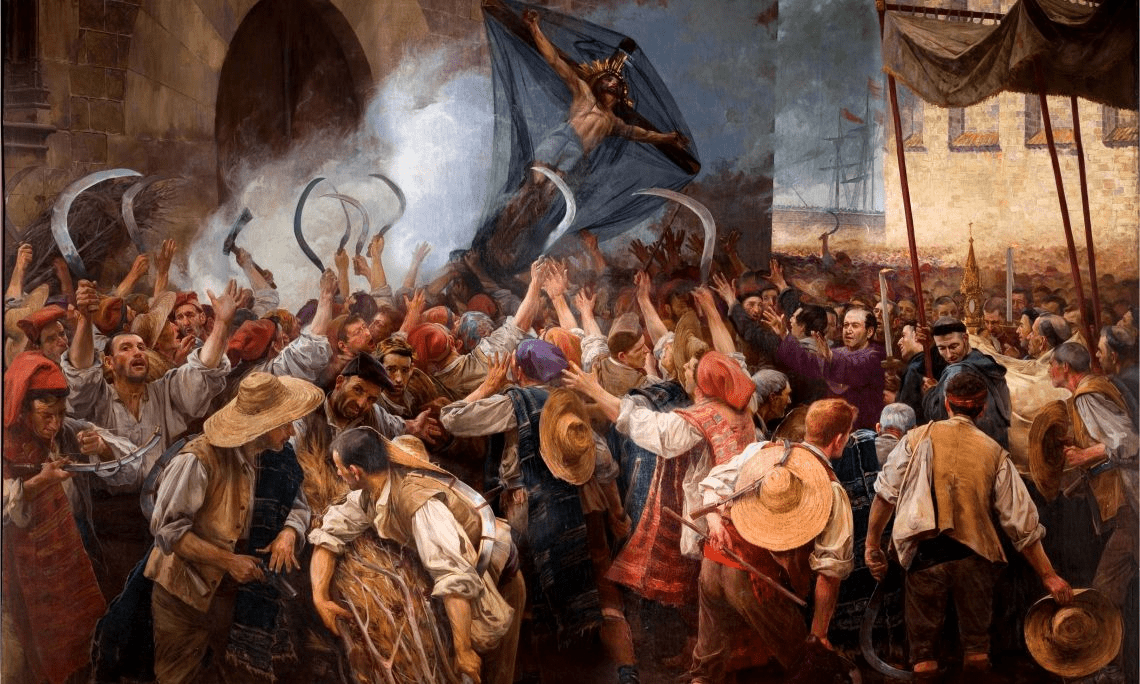
Corpus de Sang
The Corpus de Sang (Catalan pronunciation: [ˈkɔɾpuz ðə ˈsaŋ], "Corpus of Blood") was a riot which took place in Sant Andreu de Palomar and later in Barcelona on 7-10 June 1640, during Corpus Christi, which marked a turning point in the development of the Reapers' War.
-
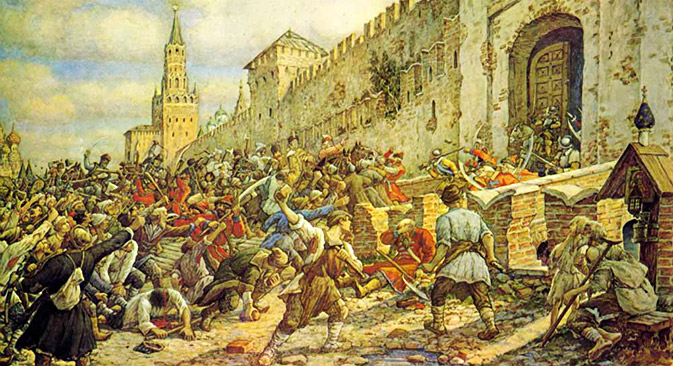
Moscow uprising of 1648
The Moscow uprising of 1648 (Russian: Соляной бунт, Московское восстание 1648), sometimes known as the salt riot, started because of the government's replacement of different taxes with a universal salt tax for the purpose of replenishing the state treasury after the Time of Troubles. This drove up the price of salt, leading to violent riots in the streets of Moscow. The riot was an early challenge to the reign of Alexei I, eventually resulting in the exile of Alexei's advisor Boris Morozov.
-

Banbury mutiny
The Banbury mutiny was a mutiny by soldiers in the English New Model Army. The mutineers did not achieve all of their aims and some of the leaders were executed shortly afterwards on 17 May 1649.
-

Vrouwenoproer van Culemborg
Het Vrouwenoproer van Culemborg was een rel in mei 1650, die in gang werd gezet door vrouwen in de Gelderse stad Culemborg.
-

Motín del hambre de Córdoba (1652)
El Motín del hambre, también conocido como Motín del pan, fue una revuelta campesina que se dio en Córdoba, España, en 1652 como consecuencia del hambre que sufrían los jornaleros de esa localidad.
-
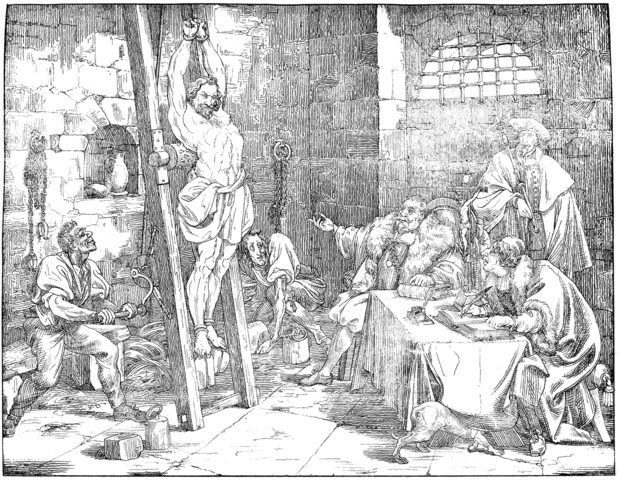
Swiss peasant war of 1653
The Swiss peasant war of 1653 was a popular revolt in the Old Swiss Confederacy at the time of the Ancien Régime. A devaluation of Bernese money caused a tax revolt that spread from the Entlebuch valley in the Canton of Lucerne to the Emmental valley in the Canton of Bern and then to the cantons of Solothurn and Basel and also to the Aargau.
-

Mellakka Kauhajoella 1658
Rakuunakapteeni Timi ja luutnantti Nandelstad hakattiin huonoon kuntoon.
-
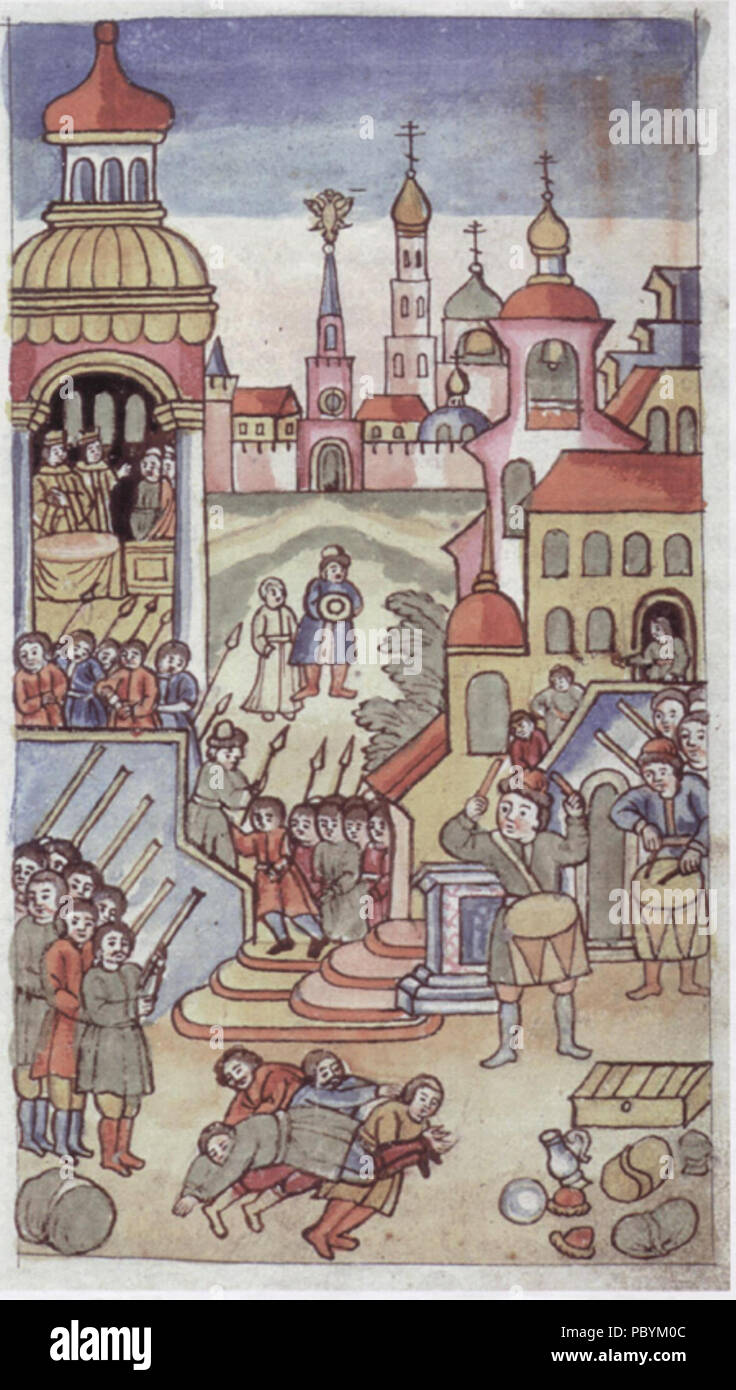
Moscow uprising of 1682
The Moscow uprising of 1682, also known as the Streltsy uprising of 1682 (Russian: Стрелецкий бунт), was an uprising of the Moscow Streltsy regiments that resulted in supreme power devolving on Sophia Alekseyevna (the daughter of the late Tsar Aleksey Mikhailovich and of his first wife Maria Miloslavskaya). Behind the uprising lurked the rivalry between the Miloslavsky and Naryshkin relatives of the two wives of the late Tsar Aleksey (died 1676) for dominant influence on the administration of the Tsardom of Russia.